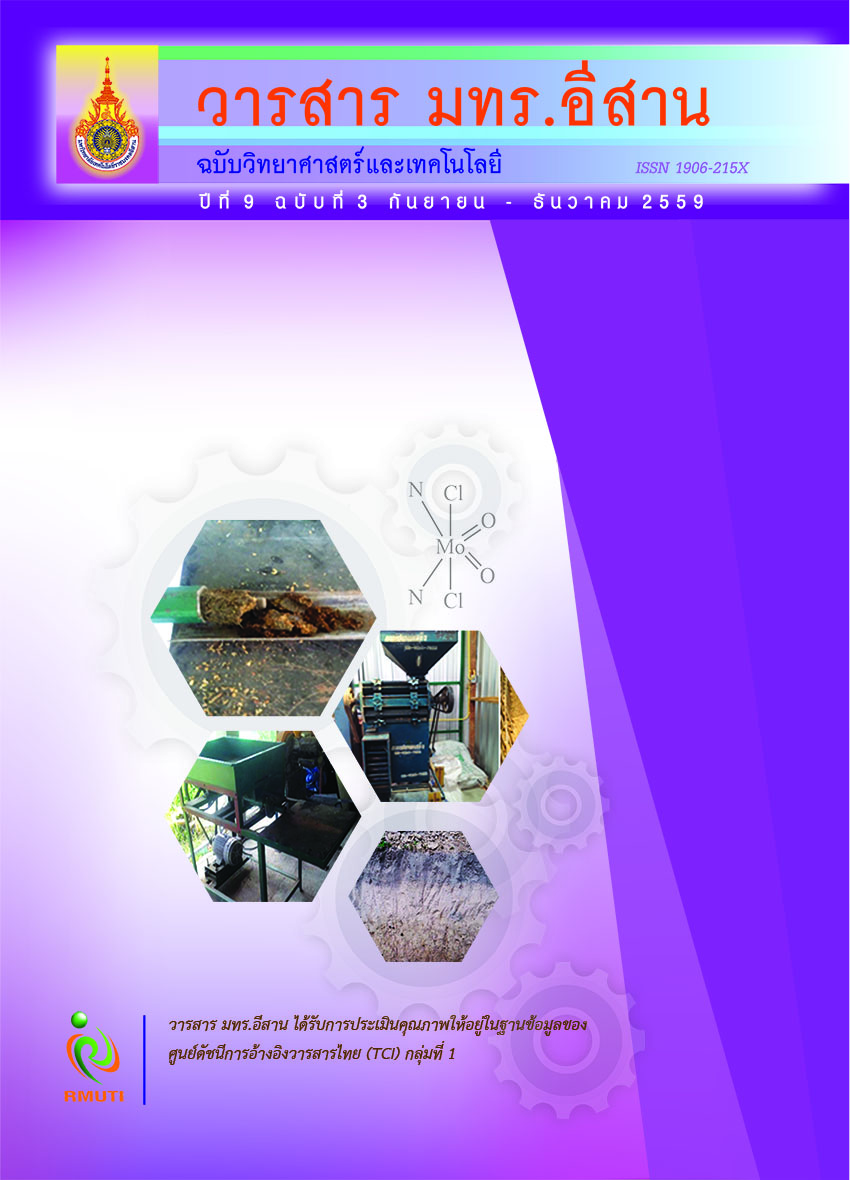Fate and Toxicity of Abamectin in Exposed Fish
Main Article Content
Abstract
Abstract
Abamectin is one of the worldwide applied insecticides generally known in many trade
names such as A.G.BA, Dimatin, Agrotin, Abama, and Jacket. It occurs in fermentation
process of soil bacterium; Streptomyces avermitilis, which produce avermectin B1a
and avermectin B1b. These substances have the same physical and toxic properties
but avermectin B1a shows higher insecticidal property. Thus, most insecticide in this
family composes of at least 80% avermectin B1a. Because of its high toxicity, it is applied
in quite few amounts. It is classified as contact and semi-systemic insecticide thus it can
control most insects such as thrips, lime butterfly, and rice leaffolder. However, it could
be released and contaminated into the waters by both intently and non-intently.
Many researches showed its harmful effects on aquatic environment especially freshwater
fish; for example, histology changes in many organs and degenerative changes in brain,
gill and kidney. Based on above information, the study on structure, mode of action,
and toxicity of abamectin is required.
Article Details
References
[2] Shayeghi, M., Khobdel, M. and Vatandoost, H. (2007). Determination of Organophosphorus Insecticides (Malathion and Diazinon) Residue in the Drinking Water. Pakistan Journal of Biological Science. Vol. 10. No. 17. pp. 2900-2904
[3] Vryzas, Z., Vassiliou, G., Alexoudis, C. and Papadopoulou-Mourkidou, E. (2009). Spatial and Temporal Distribution of Pesticide Residues in Surface Waters in Northeastern Greece. Water Research. Vol. 43. pp. 1-10
[4] Werimo, K. Bergwerff, A.A. and Seinen, W. (2009). Residue Levels of Organochlorines and Organophosphates in Water, Fish and Sediments from Lake Victoria-Kenyan portion. Aquatic Ecosystem Health and Management. Vol. 12. pp. 337-341
[5] Arjmandi, R. Tavakol, M. and Shayeghi, M. (2010). Determination of Organophosphorus Insecticide Residues in the Rice Paddies. International Journal Environmental Science Technology. Vol. 7. No. 1. pp. 75-182
[6] Halley, B.A., Van den - Heuvel, W.J.A. and Wislocki, P.G. (1993) Environmental
Effects of the Usage of Avermectins in Livestock. Veterinary Parasitology. Vol. 48.
pp. 109-125
[7] Jen .i , V., Cerne, M., Erzen, N.K., Kobal S. and Cerkvenik-Flajs, V. (2006). Abamectin Effects on Rainbow Trout (Oncorhynchus mykiss). Ecotoxicology. Vol. 15. No. 3. pp. 249-257
[8] Al-Kahtani, M.A. (2011). Effect of an Insecticide Abamectin on Some Biochemical Characteristics of Tilapia Fish (Oreochromis Niloticus). American Journal of Agricultural and Biological Sciences. Vol. 6. No. 1. pp. 62-68
[9] CEPA. (1993). Canadian Environmental Protection Act. Priority Substances List Assessment Report: Hexachlorobenzene. Ottawa: Canada Communication Group Publishing.
[10] Turner, M. and Schaeffer, J. (1989). Mode of Action of Ivermectin. In Ivermectin and Abamectin, New York: Springer-Verlag, pp. 73-88
[11] El-Said, M.M. (2007). Evaluation of Abamectin Toxicity on Some Biochemical Constituents and Osmoreulation in Freshwater Fish Oreochromis niloticus (Tilapia niloticus). Journal of Egypt society of Toxicology. Vol. 37. pp. 1-10
[12] Molinari, G., Soloneski, S. and Larramendy, M.L. (2010) New Ventures in the Genotoxic and Cytotoxic Effects of Macrocyclic Lactones, Abamectin and Ivermectin. Cytogenetic and Genome Research. Vol. 128. pp. 37-45
[13] Stegeman, J.J., Hahn, M.E. (1994). Biochemistry and Molecular Biology of Monooxigenases: Current Perspectives on Forms, Functions and Regulation of Cytochrome P450 in aquatic species. In - Aquatic Toxicology: Molecular, Biochemical and Cellular Perspectives. ed. D.C. Mallins, G.K. Ostrander, CRC Press, Boca Raton, FL, pp. 87-206
[14] Nabb, D.L., Mingoia, R.T., Yanh, C.H. and Han, X. (2006). Comparison of Basal Level Metabolic Enzyme Activities of Freshly Isolated Hepatocytes from Rainbow Trout (Oncorhynchus mykiss) and Rat. Aquatic Toxicology. Vol. 80. pp. 52-59
[15] Ferrari, A., Venturino, A. and de D’Angelo, A.M. (2007). Effects of Carbaryl and Azinphos Methyl on Juvenile Rainbow Trout (Onchorhynchus mykiss) Detoxifying enzymes. Insecticide Biochemistry and Physiology. Vol. 88. pp. 134-142
[16] Riga, M., Tsakireli, D., Ilias, A., Morou, E., Myridakis, A., Stephanou, E.G., Nauen, R., Der, W., Leeuwen, T.V.J. and Vantos, M.P. (2014). Abamectin is Metabolized by CYP392A16, a Cytrochrome P450 Associated with Hidh Levels of Acaricide Resistance in Tetranychus Urticae. Insect. Biochmical and Molecular Biology. Vol. 45. pp. 43-53
[17] Mushigeri, S.B. and David, M. (2005). Fenvalerate Induced Changes in the Ach and Associated AchE Activity in Different Tissues of Fish Cirrhinus mrigala (Hamilton) Under Lethal and Sub-Lethal Exposure Period. Environmental Toxicology and Pharmacology. Vol. 20. pp. 65-72
[18] Banaee, M., Mirvagefei, A.R., Rafei, G.R. and Amiri, B.M. (2008). Effect of Sub-lethal Diazinon Concentrations on Blood Plasma Biochemistry. International Journal of Environmental Research. Vol. 2. pp. 189-198
[19] Kavitha, P. and Rao, J.V. (2009). Sub-Lethal Effects of Profenofos on Tissue-Specific Antioxidative Responses in a Euryhyaline Fish, Oreochromis mossambicus. Ecotoxicology and Environmental Safety. Vol. 72. pp. 1727-1733
[20] Barile, F.A. (2007). Principles of Toxicology Testing. N.Y. : CRS press
[21] Wislocki, P.G., Grosso, L.S. and Dybas, R.A. (1989). Environmental Aspects of Abamectin use in Crop Protection. In: Campbell WC, Eds. Ivermectin and abamectin. N.Y. : Springer Verlag, pp. 182-200
[22] Van den Heuvel, W.J.A., Forbis, A.D., Halley, B.A., Ku, C.C., Jacob, T.A. and Wislocki, P.G. (1996). Bioconcentration and Depuration of Avermectin B1a in the Bluegill Sunfish. Environmental Toxicology and Chemistry. Vol. 15. No. 12. pp. 2263-2266
[23] Seeduangkaew, J., Kulsarin, J., Buranapanichpan, S. and Kumpiro, S. (2015). Biology of Cotton Leafhopper and Efficacy of Insecticides for Controlling in Purple Eggplan. Agriculture research. Vol. 31. No. 2. pp. 193-201

